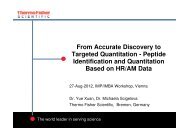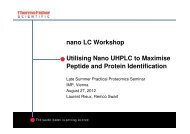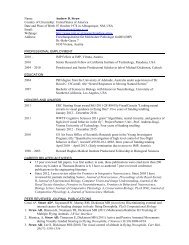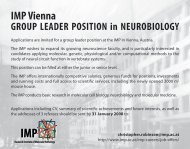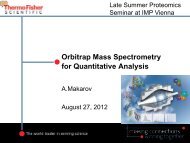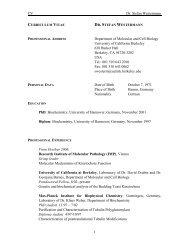IMP Research Report 2002
IMP Research Report 2002
IMP Research Report 2002
You also want an ePaper? Increase the reach of your titles
YUMPU automatically turns print PDFs into web optimized ePapers that Google loves.
and JNP differentially regulate cell proliferation,<br />
differentiation and apoptosis in diverse biological<br />
processes.<br />
JunB and Fos as tumour suppressors<br />
JunB is a transcriptional activator of the cyclindependent<br />
kinase inhibitor p16/INK4a and functions as<br />
a negative regulator of cell proliferation. Using different<br />
in vivo approaches including conditional inactivation we<br />
Figure 2: Functional analysis of Fra-1.<br />
an eye closure defect during embryonic development,<br />
and skin tumour development. Chondrocyte-specific<br />
inactivation resulted in severe scoliosis caused by<br />
abnormal intervertebral disc formation suggesting that<br />
Jun is a novel regulator of sklerotomal differentiation<br />
(Figure 3).<br />
An important mechanism regulating Jun activity is its<br />
phosphorylation at serine 63 and 73 by Jun aminoterminal<br />
kinases (JNKs). Null mutations in Jnk1 and<br />
Jnk2 genes (collaboration with M. Karin, UCSD), as<br />
well as a jun allele mutated in the JNK phosphoacceptor<br />
sites (JunAA), were generated. Jnk1-/-, Jnk2-/- and<br />
JunAA mice are healthy and fertile, however the<br />
absence of Jnk1 and Jun-N-terminal phosphorylation<br />
(JNP) results in growth retardation and in fibroblast<br />
proliferation defects. Jnk1-/- Jnk2-/- double mutants<br />
develop brain defects, and Jnk2-/- and JunAA<br />
thymocytes are resistant to CD3-induced apoptosis.<br />
Moreover, Jnk1 and Jun phosphorylation are required<br />
for osteoclast differentiation. Therefore, JNK signalling<br />
have shown that the absence of JunB expression in<br />
the myeloid lineage results in a transplantable<br />
myeloproliferative disease, which eventually progresses<br />
to blast crisis resembling human chronic myeloid<br />
leukemia. Thus, JunB was identified as a key<br />
transcriptional regulator of myelopoiesis, which controls<br />
the number of granulocyte progenitors through inhibition<br />
of proliferation and promotion of apoptosis.<br />
When the fos-/- osteopetrotic mice were crossed into<br />
the p53 background, double mutant mice developed<br />
rhabdomyosarcomas (Figure 1). Re-expressing Fos in<br />
the double mutant muscle tumour-derived cell lines<br />
induced apoptosis revealing a novel, totally unexpected<br />
function of the proto-oncogene Fos as a potential<br />
tumour suppressor in the muscle lineage.<br />
Functional studies of VEGF, VEGF-R2/Flk-1<br />
and EGF-R<br />
The VEGF/Flk-1 signalling system is essential for the<br />
development of endothelial and hematopoietic cells.<br />
To test Flk-1’s role in adult mice and in tumour<br />
angiogenesis a conditional allele of Flk-1 was<br />
generated. In addition, a conditional allele of VEGF was<br />
used to analyse the functional importance of VEGF-A<br />
in developing chondrogenic tissues and to study the<br />
role of VEGF-A in skin biology (collaboration with Erwin<br />
Tschachler, General Hospital, Univ. Vienna). Finally,<br />
conditional and mutated EGF receptor alleles are<br />
employed to study the role of EGF-R in skin tumour<br />
development (collaboration with Maria Sibilia, Dept. of<br />
Dermatology, Univ. Vienna).<br />
Figure 3: Functional analysis of Jun in development and disease.<br />
Contact: wagner@imp.univie.ac.at<br />
39




